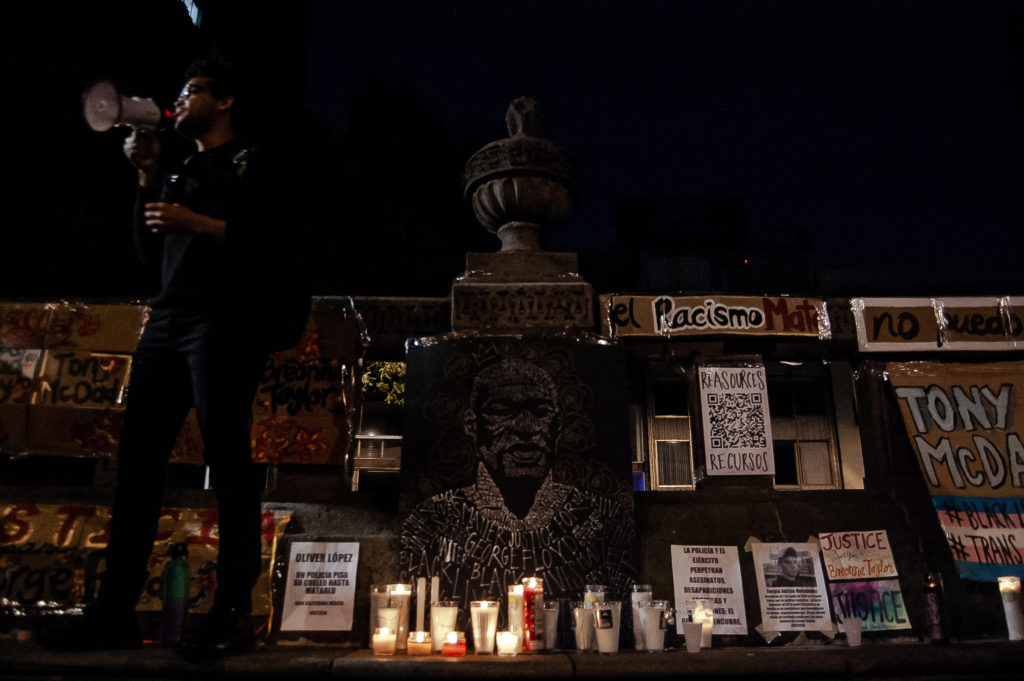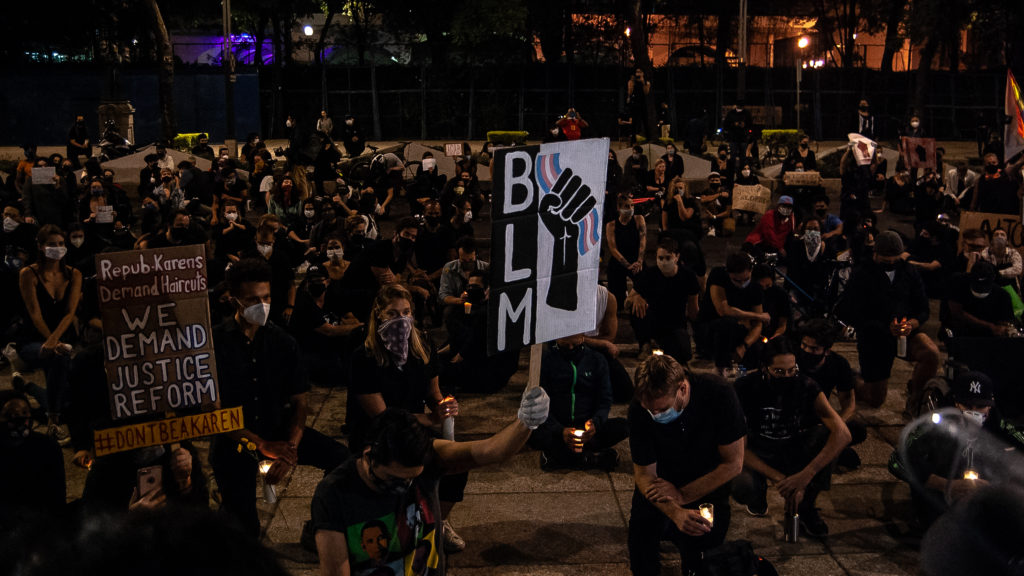As dusk descended on Mexico City Thursday, Ebony Bailey took a megaphone in front of a crowd of several hundred across the street from the US Embassy. The people around her, faces covered with masks, cradled candles and held aloft Black Lives Matter signs.
Bailey, a member of the Black women’s collective Flores de Xamaica, read out a statement first in Spanish, then in English. “Saying there are no Black people in Mexico turns into the systematic profiling and othering of Black bodies here in Mexico,” she read to the crowd. “The anti-racist struggle in the United States is the same struggle in Mexico and Latin America.”

As demonstrators gathered in Mexico City, others met in the streets of Guadalajara in a demonstration against the killing of Giovanni Lopez, a construction worker in the state of Jalisco who police beat to death last month. Many were detained, including over two dozen whose whereabouts were unknown until midday Saturday.
Mexicans have flooded social media with statements of support for protests in the US against anti-Black violence, triggered by police murders of George Floyd and Breonna Taylor. But often, the posts are accompanied with qualifying comments: the common refrain that Mexico is ripe with classism, but not racism; that there are no Black people in Mexico; that Mexico doesn’t have issues of police violence.
Yet Mexico is home to a significant Afro-descendent population, and anti-Black violence is systemic. At Thursday’s vigil and beyond, members of the African diaspora in Mexico are pushing to highlight the international nature of the anti-Black violence driving people to the streets in the US.
Many of Thursday’s protestors were people from the US living in Mexico, like Miguel Castillo, who grew up in San Diego. He’s been monitoring protests for friends in LA and New York. “As a person of color in the US, I have friends who’ve been victims of race violence,” he says. “I’m watching like four different cameras, like boom… police kettling people, don’t go down these alleyways. This is probably the closest I can get to being around people and actually find solidarity.”
In Mexico, police violence is endemic. A few hundred meters down from the vigil loomed the Angel of Independence, the monument walled off since last August, when protestors tagged the structure during a march spurred by two cases of police raping young women. And several hundred meters up Paseo de la Reforma from where we gathered, the camp for the 43 students of Ayotzinapa disappeared after being detained by police in 2014 remained.
Amidst the ubiquity of police violence, though, Black folks in Mexico are largely invisibilized. Mexico is home to an Afro-descendent population of approximately 1.3 million, according to a 2017 study by Mexico’s National Human Rights Center, though precise numbers don’t exist. The country has legally recognized Afro-Mexicans as such since only last year.
The 2020 census, cut short by the pandemic, marked the first time the Mexican government attempted to count the Afro-Mexican population. Police and civilians alike commit violence against Afro-Mexicans and Black migrants in Mexico.
Last year, Carmen Parral Santos, Afro-Mexican municipal president of the town San José Estancia Grande, Oaxaca, was murdered alongside another Afro-Mexican woman in Oaxaca.
Aside from the Afro-Mexican population, violence is common against other members of the African diaspora in Mexico. In 2013, Malcolm X’s grandson Malcolm L. Shabazz was beaten to death in downtown Mexico City.
In recent years, increasing numbers of African and Haitian migrants and asylum-seekers have crossed the country to reach the US. They’ve denounced systematic discrimination and violence both by the Mexican state and civilians. African migrants in immigration detention have been beaten by officials. Last year, a Haitian man, Maxene Andre, died in immigration detention in Tapachula, Chiapas.
Leona Ujuru is a member of Flores de Xamaica originally from the northern periphery of Mexico City. “In the US, these cases are made known and go viral,” she told me as the protest wound down. “[They don’t] in Mexico City, but that doesn’t mean that they don’t happen. In the United States it’s more clear that these things happen, that they murder someone for being Black, but in Mexico it also happens.”

Anti-Blackness in Mexico, as in the US, is rooted in the western hemisphere’s history of colonialism and the transatlantic slave trade. In addition to members of the Afro-Mexican community, the Flores de Xamaica collective includes members from Ghana, the UK, the US and beyond.
Waquel Drullard is a non-binary person from the Dominican Republic who’s lived in Mexico for seven years. During the protest, they took the megaphone to speak about the colonial nature of anti-Blackness in the Americas.
“All of us in the Americas come from those 12 million Africans who were taken away as slaves,” they said. “We’re all living within the white European logic, the logic of important subjects from the French revolution, where you have to be white, a property owner, bourgeois, adult, male.”
Being from the Dominican Republic, Drullard’s particular experiences of anti-Blackness transcend borders. “I’ve lived through racism in Mexico since I arrived at the airport and I experienced discrimination in super extreme inspections,” they said.
“They’ve yelled at me in the street that I [should] fix my hair, they call me Blacky. It doesn’t matter that we’re in Latin America or Europe or the US. All the Black people who aren’t in Africa come from people that were taken, trafficked. More international, transnational solidarity should exist,” Drullard says. “More than being from the US or another region, we are Black. A Black life that they murder in the US also hurts us on this side.”
The several hundred gathered took a knee for eight minutes and 49 seconds, commemorating the period of time that police officer Derek Chauvin kneeled on George Floyd’s neck. People took turns reading aloud the names of Black victims of police violence since Eric Garner was murdered by the NYPD on July 27, 2014.
“There are many foreigners here,” Drullard called out to the crowd. “I hope you’re also here for the more than 60,000 disappeared people in Mexico, the students from Ayotzinapa. I invite you to raise your hands, to protest with your bodies, because the revolution is now.”
On Friday another demonstration gathered on Reforma, across the street from the US Embassy to remember both George Floyd and Giovanni Lopez. The night before, the Embassy erected additional metal barricades to keep demonstrators away from the fence that surrounds it.
As protestors made their way to the headquarters of the state of Jalisco, breaking bank windows on the way, riot police met them with tear gas. Police repeatedly kicked a 16-year-old girl, who remains hospitalized, in the head.
Later that evening in Guadalajara, plainclothes police in unmarked vehicles detained several dozen people on their way to yet another protest demanding justice for Giovanni Lopez. As this story goes to press, activists monitoring the situation are unsure whether anyone remains missing.
As protests continued across the US on Saturday, activists in Guadalajara were on the streets demanding the safe return of their comrades. Another protest is planned Sunday in Mexico City for Melanie, the teenager in hospital with a head injury from Friday’s police attack.
Author Bio
Madeleine Wattenbarger is a journalist in Mexico City, where she covers human rights, politics and urbanism, among other topics. She tweets at @madeleinewhat.
Photographer Bio
Javier Perea is a photographer in Mexico City, where he studies social anthropology at the Universidad Autónoma Metropolitana.
